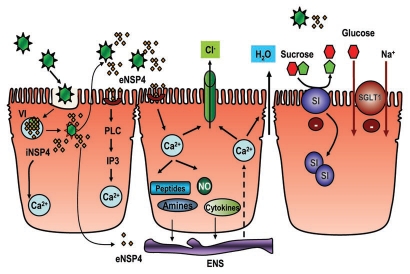Figure 7.
Mechanisms of rotavirus-mediated diarrhea. Rotavirus infection of enterocytes leads to virus entry, formation of viroplasms (VI) and release of the virus and its toxin, NSP4. Intracellular NSP4 (iNSP4) induces an increase in intracellular Ca2+ primarily through release from er and a PLC-independent mechanism. NSP4 released from the apical side increases intracellular calcium levels through a receptor-mediated PLC-dependent mechanism. The increase in calcium by NSP4 disrupts microvillus cytoskeleton as well as barrier function, leading to an increase in the paracellular flow of water and electrolytes, causing diarrhea. The NSP4 induced increase in Ca2+ levels can also increase Cl− secretion directly through a CFTR-independent mechanism and can cause release of amines, peptides, cytokines and reactive oxygen species, which can stimulate the enteric nervous system indirectly to increase Cl− secretion. The basolateral release of NSP4 may also stimulate ENS. Maldigestion of carbohydrates due to a decrease in surface levels of sucrase-isomaltase and decreased function of SGLT-1 appears to be a major mechanism underlying diarrhea caused by rotavirus infection. eNSP4 is extracellular NSP4.

